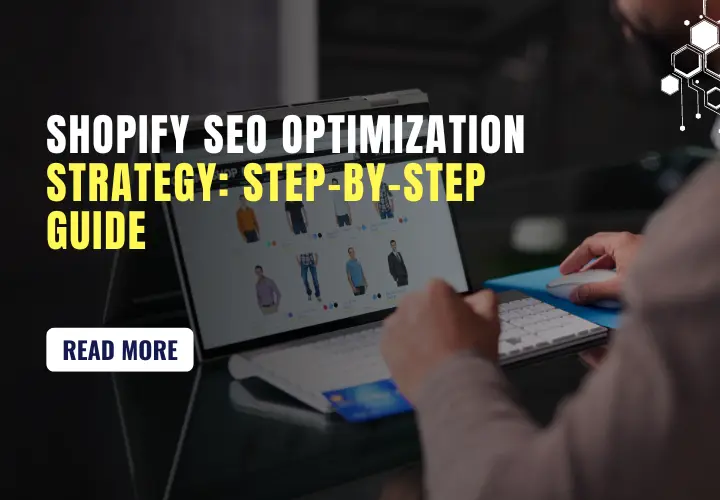Shopify SEO Optimization Strategy: Step-by-Step Guide
When it comes to e-commerce platforms, Shopify is undoubtedly one of the best options. Shopify is used by over 4.46 million businesses worldwide and has a market share of 28% among US websites using e-commerce technologies. This makes it clear that Shopify is a go-to choice for online retailers.
Although many businesses set up their Shopify stores quickly, they miss out on fully benefiting from this platform because they are unaware of Shopify SEO (search engine optimization). If you want your store to thrive in the highly competitive e-commerce marketplace and be visible to your target audience, you need to master Shopify SEO.
In this step-by-step guide, you’ll learn how to use SEO correctly to rank your store higher in the search engines and attract more customers.
Why Is Shopify SEO Important?
Before we get into the details of SEO, let’s talk about why Shopify SEO is so important:
- Experience Increased Visibility: Proper SEO helps your store appear higher in search results, making it more likely for potential customers to find you.
- Get Higher Quality Traffic: SEO attracts users who are actively searching for products like yours, which leads to better conversion rates.
- Enjoy Cost-Effective Marketing: Once your SEO is set up, it continues to work for you 24/7, unlike paid advertising, which stops when you stop paying.
- Build Brand Credibility: Ranking high in search results builds trust with potential customers, as they often associate top results with reputable brands.
- Gain a Competitive Edge: Many Shopify store owners neglect SEO, which means optimizing your store can give you a major advantage over your competitors.
Now that we understand why Shopify SEO is important for your store, let’s get into our step-by-step guide.
Step 1: Do Thorough Keyword Research
Effective keyword research is the foundation of an SEO strategy. It will help you learn what your target audience searches for and how your content can meet their needs.
Here’s how to research keywords for your Shopify store in an efficient manner:
- Use Keyword Research Tools: There are many useful keyword research tools like Ubersuggest, Ahrefs, or SEMrush to find relevant keywords for your products and industry.
- Focus on Long-Tail Keywords: Long-tail keywords are longer, more specific phrases that usually have less competition and higher conversion rates.
- Analyze Competitor Keywords: Look at the keywords your successful competitors are ranking for and find ways to compete or find related niches.
- Look at Search Intent: Make sure the keywords you choose are related to the user’s search intent (informational, navigational, or transactional).
- Study Search Trends: Use tools like Google Trends to understand seasonal patterns of popular keywords. This will help you plan product promotions and content when interest is highest.
- Look for Question-Based Keywords: Use question-based keywords (e.g., “how to,” “what is”, “where can I buy”, etc.) in your content strategy. These usually have lower competition and can be great for targeting informational searches.
- Use Local Keywords: If you have a physical store or are targeting specific locations, include location-based keywords in your research (e.g., “handmade jewelry in Toronto”).
Remember that finding high-volume keywords is not the only thing to do. The best keywords for your Shopify store will balance search volume, product relevance, and level of competition.
Step 2: Improve the Structure of Your Shopify Store
You must have a well-organized store structure if you want to improve the user experience and SEO of your Shopify store. To improve the structure of your Shopify store:
- Create a Logical Hierarchy: Organize your products into categories and subcategories to make your inventory more sensible.
- Optimize URL Structure: Although Shopify automatically creates SEO-friendly URLs, you can improve them even more by keeping them short and including relevant keywords in them.
- Use Breadcrumbs: Breadcrumbs are small links on a website that show users where they are and how to go back. They help users (and search engines) understand the structure of your site and improve navigation.
- Limit Depth: Try to keep each page within three clicks of the homepage to ensure good crawlability.
- Set up Faceted Navigation: If your store has large product catalogs, use faceted navigation. This will allow users to filter products by size, color, or price range, which improves the user experience and helps search engines understand your product relationships.
- Use Clear, Descriptive Menu Labels: Make sure your navigation menu has clear, descriptive labels with relevant keywords (wherever possible). This will help both users and search engines understand your site structure.
- Create an HTML Sitemap: In addition to your XML sitemap, create an HTML sitemap that users can also view. This will help both visitors and search engines explore your site more effectively.
Step 3: Optimize On-Page SEO Elements
On-page SEO means optimizing each page on your Shopify store. The points to keep in mind are:
- Title Tags: Keep the title tag under 60 characters and include your primary keyword.
- Meta Descriptions: Write compelling descriptions that are rich in keywords and are under 160 characters.
- Header Tags: Use H1 for page titles and H2 and H3 for subheadings, and remember to add relevant keywords to them.
- Product Descriptions: Write detailed product descriptions and add your target keywords to them in a natural way.
- Alt Text: Describe your images accurately and include relevant keywords.
To edit these elements in Shopify:
- Go to your Shopify admin panel
- Click on “Online Store” > “Preferences“
- Scroll down to “Search engine listing preview“
- Click “Edit website SEO“
Although keywords are important, your priority must be to create high-quality, user-friendly content.
Step 4: Enhance Site Speed and Performance
Site speed has a big impact on the user experience and is essential for SEO rankings. Here’s how you can optimize your Shopify store’s speed:
- Optimize Images: Compress images and use the right file format (JPEG for photographs, PNG for graphics with transparent backgrounds).
- Minimize Apps: Get rid of any unused apps, as they can decrease the speed of your website.
- Use a Fast, Responsive Theme: Choose a Shopify theme that’s fast and compatible with all devices.
- Use Browser Caching: To make your pages load more quickly on the next visit, enable caching on your visitors’ devices.
- Minimize HTTP Requests: Reduce the number of elements—such as scripts, stylesheets, and images—on your page that need separate HTTP requests.
- Enable Lazy Loading: Implement lazy loading for images and videos, so they only load when a user scrolls to that part of the page.
- Use a Content Delivery Network (CDN): Shopify automatically uses a CDN, but make sure your store is properly set up.
Google PageSpeed Insights and GTmetrix are two tools that you can use to analyze the speed of your store and receive detailed recommendations for improvement.
Step 5: Create High-Quality, SEO-Friendly Content
Content is truly the king in the world of SEO. Useful content with your targeted keywords can bring more customers to your store than you think.
- Start a Blog: You can use the built-in blogging platform of Shopify to create informational content and use keywords related to your products and industry in the blog naturally.
- Create Product Guides: Write in-depth guides that talk about your products and use relevant keywords in them. These helpful guides can help customers understand your products and increase interest.
- Create Video Content: Create product demonstrations or how-to videos to engage users. This strategy can help you appear in video search results.
- Create FAQ Pages: Answer the common questions customers ask about your products and services while targeting long-tail keywords.
- Write Engaging Meta Descriptions: Create compelling meta descriptions that have keywords built into them, which will help the search engine rank the content and encourage clicks from search results.
- Use Semantic Keywords: Include related terms and synonyms in your content to help search engines understand the context of your pages.
- Keep Content Fresh: Update your content regularly to keep it relevant and signal to search engines that your site is active.
Step 6: Build High-Quality Backlinks
Backlinks from reputable websites indicate to search engines that your website is trustworthy and authoritative. For high-quality backlinks, try the following strategies:
- Guest Blogging: Write articles for reputable blogs in your industry, including a link to your website.
- Product Reviews: Offer your products to influencers or industry experts in exchange for honest reviews.
- Create Shareable Content: Create infographics, studies, or other valuable content that others will want to share.
- Participate in Industry Forums: Engage in industry-relevant discussions and include links to your store where suitable.
- Build Partnerships: Collaborate with suppliers, manufacturers, or complementary businesses for mutual link-building opportunities.
- Use HARO (Help a Reporter Out): Respond to journalists’ queries to get quoted in news articles, often with a backlink to your site.
- Create Resource Pages: Develop detailed resource pages that other sites in your industry would want to share as a valuable reference.
Remember, it’s about quality over quantity. A few links from high-authority sites are more valuable than many links from low-quality sites.
Step 7: Use Social Media for SEO
Even though social media doesn’t affect ranking directly, it can still help your SEO efforts indirectly:
- Share Your Content: Promote your blog posts and product pages on social media to increase visibility and earn some backlinks.
- Engage with Your Audience: Respond to comments and messages swiftly to build a loyal community.
- Use Social Proof: Highlight customer reviews and testimonials on your social media profiles and your Shopify store.
- Optimize Social Profiles: Include keywords in your social media bios and link back to your Shopify store.
- Encourage User-Generated Content: Run contests or campaigns that motivate consumers to create and share content featuring your products.
- Add Social Sharing Buttons: Make it easy for visitors to share your products and content on their social media profiles.
Step 8: Monitor and Analyze Your SEO Performance
SEO is a continuous process, and it’s important to track your progress and adjust your strategy accordingly. Here’s how you can do that:
- Use Google Analytics: Connect your Shopify store to Google Analytics so you can track the traffic, user behavior, and conversions.
- Set Up Google Search Console: This tool provides helpful insights about how Google sees your site and helps you find and fix any issues there might be.
- Track Keyword Rankings: Use tools like Ahrefs or SEMrush to track your rankings for target keywords.
- Monitor Core Web Vitals: These performance indicators are becoming more and more important for SEO, so pay attention to them.
- Set Up Custom Reports: Create custom reports in Google Analytics to track the metrics most relevant to your business goals.
- Conduct Regular SEO Audits: Perform SEO audits every few months to find areas for improvement and new opportunities.
Reviewing these metrics regularly will help you understand what’s working and where you need to improve your Shopify SEO strategy.
Conclusion
Optimizing your Shopify store for SEO can be one of the best steps you can take to get your store noticed. But to see considerable effects and results, you need to be consistent and patient. The long-term benefits of these steps are worth all the effort.
If you follow this guide and continue to work on SEO, it will not take long before your Shopify store will be on top of your targeted search results, leading to more sales.
Latest posts by Vijaya Tyagi (see all)
Important Tips & Tactics to Boost Your Website Reputation!! - October 16, 2025
14 Years, Thousands of Campaigns, Countless Stories – And We’re Just Getting Started - September 29, 2025




